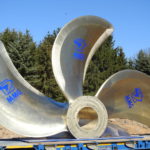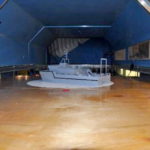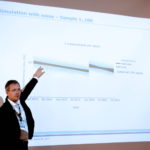At this year’s second Hull Performance & Insight Conference (HullPIC 2.0) in Ulrichshusen from 27 to 29 March more than 100 attendees discussed ways to make the ships hull more efficient. HANSA informs on the main results
Many fuel-saving technologies (such as advanced coatings or energy saving devices) are not adopted, because the industry does not[ds_preview] trust the promises or because contracts fail to create win-win
situations. »Ship owners maintain a degree of skepticism around fuel and CO2 saving predictions. The lack of accurate and transparent supporting data underpinning statistics quoted has contributed to this mindset,« confirmed Barry Kidd (Akzonobel). ISO 19030 is expected to bring major improvements in this respect. The standard on hull and propeller performance for fleet in service was published in November 2016, moving the discussion from the smaller circle of experts in the working group to the wider public.
HullPIC 2.0 brought developers and ship operators together to exchange experiences in the still evolving field of performance management, especially in the light of ISO 19030. The topic apparently strikes a nerve in the industry. »Since the beginning of the ISO 19030 development, many shipping companies and operators have taken interest in the standard,« said Beom Jin Park (KRISO). Despite the complex, technical challenges involved, the response to the conference was impressive. For those who could not attend, the proceedings of the conference can be downloaded free of charge from www.hullpic.info. References and quotes given below are all from HullPIC 2017.
While there is wide consensus that performance monitoring is necessary and good, there remains controversy over the ISO 19030 standard approach. Is it too complicated and costly? Is it too simplistic and inaccurate? »ISO 19030 delivered on its stated aims, but that does not prevent us from having ideas for further work,« concluded Geir Axel Oftedahl (Jotun), secretary of the ISO 19030 working group. »[The ISO 19030] methods are […] not so easy to implement for ship operators. […] the accuracy of measurements [is lower than] considered in ISO 19030. [… And] even with built-in filters and long time span of evaluation and reference periods, continuous analysis of performance does not show much consistency,« said Park et al. (KRISO). In the open spirit of HullPIC, common ground was found between these positions. »More discussion is needed« was frequently used and might have been the unofficial theme of the conference.
What’s your baseline?
From a distance, performance monitoring looks quite simple: You monitor how the power needed for a given speed increases over time due to fouling. »However, there are numerous challenges and pitfalls when discussing the absolute level of hull and propeller performance,« elaborated Andreas Krapp (Jotun). Raw data need to be corrected (»normalized« in expert jargon) for varying operational and ambient conditions. In essence, we need to make numbers comparable, correcting for differences to a standard reference condition. This task requires a model to determine for example differences in power requirements for different draft or different wind conditions. The model used in the evaluation of the performance data can be built on physical models (white box), derived directly from observed data (black box) or a combination of both (grey box), said Dafni Sofiadi et al. (ABS). Depending on the approach, models have largely varying accuracy.
The problems start at the very core of performance monitoring: the speed-power relation or »baseline«. While measuring the shaft power is relatively straightforward, the notorious speed through water (STW) remains an Achilles’ heel for performance monitoring. »We find two main categories of quality issues. First, the [speed] logs are often miscalibrated, i.e. the measured [speed] is constantly too large or two small in certain speed ranges. Second, sometimes [speed] logs will provide noisy and clearly erroneous measurements.« Eric Giesberg (NSWC-CD) contributed a scientific study on the (in)accuracy of logs, finding acoustic Doppler current profiler reliable and accurate, while electro-magnetic logs was found to have issues beyond calibration offsets. His work reopened the discussion on using GPS speed over ground data as input data for performance monitoring. Michael Haranen (Napa) also questioned the ISO 19030 approach relying solely on speed-log data asking whether it is »better to use speed log signal or should we calculate the ship speed through water from the speed over ground and ocean currents forecast data«. More discussion is needed, I guess.
Hull roughness and resistance
Performance monitoring and the HullPIC conference seemed to follow Albert Einstein’s adage: »The more I learn, the more I realize how much I don’t know.« The discussion around performance monitoring has brought to light that we don’t know enough about the basic correlation between hull roughness and resistance. Now, some fundamental studies shed at least some more light on the topic. Bercelay Niebles and Valery Chernoray (Chalmers Technical University) used advanced CFD (Computational Fluid Dynamics) to obtain the roughness function of any arbitrary rough surface. The approach »is considerably cheaper in terms of resources and time when compared with experimental approaches«. The roughness functions obtained can then be used in simulations for ships, mimicking marine coatings with different roughness. Various groups contributed similar insight on the effect of different coatings with different roughnesses, using simulations (Tom Goedicke, MMG, Abel Vargas and Hua Shan, NSWC-CD), experiments in model basins (Rhena Klose and Reinhard Schulze, SVA Potsdam), or both (Kourosh Koushan et al., Sintef Ocean).
Baselines refer to the ship in calm water, typically for design condition and sea-trial condition. But most ships operate in off-design conditions in actual service. Speed-power curves depend on the loading condition (draft and trim). Popular schemes interpolating from baseline curves are unable to reflect the complex nonlinearities of hull resistance at intermediate drafts and varying trim. Instead, using loading condition specific speed-power curves is recommended. This was shown for container ships last year. Now Andreas Krapp and Daniel Schmode (Jotun and DNV GL) have extended the study to a variety of cargo ships, showing CFD-based interpolation to be clearly superior. The findings are not only of interest for hull and propeller performance, but impact also speed-trial analysis procedures and EEDI calculations.
Effects that change consumption
Ambient conditions change power consumption: sea state (significant height, distribution, direction), wind (speed and direction), water temperature, water depth and current (speed and direction). Here, Volker Bertram (DNV GL) added »some heretic thoughts on ISO 19030« to raise awareness of some sources of inaccuracies in the standard procedure. »Water temperature affects viscosity and thus resistance. Variations of 2–3% of calm-water resistance in design condition may result. Wind force corrections are simple and cheap. In turn, they […] have large errors. […]. Current speed plays a role because it varies over depth. A filtering condition for significant current speed should be used, rather than a correction.«
Yuan Zeng et al. (TU Delft) discussed very shallow water effects with a recommendation for a modified friction line. For most ships in usual operation, water depth can be neglected as factor.
Performance monitoring starts with accurate data acquisition. If the sensors give wrong or no data then performance monitoring is doomed from the beginning. »It is very well known that data collected on-board ship may be inaccurate and biased«, said Haranen (Napa).
The standard ISO 19030 approach requires high-frequency data logging. This requirement has been a matter of discussion from the very beginning as it means additional hardware installation and investment for most ship operators. »Traditional high-fidelity data acquisition techniques are typically expensive since they require cabling and integration into the vessel’s automation system. Especially on small to moderately sized or chartered vessels, the high cost makes such solutions unfeasible,« Stratos Staboulis (Eniram) pointed out. On the other hand, there are »problems typical to the traditional noon-report based approach such as crew over-reporting weather conditions and other inaccuracies preventing rigorous physical modeling.« Higher data frequency is useful in many cases, but is it necessary? There are still opposing opinions on this matter. And does »much data« equal »much insight«? In the words of Bjarte Lund and Carlos Gonzalez (Kyma): »The challenge with the Big Data concept is, however, to convert this huge amount of real-time data into smart data.«
»Errors can be random [noise] or systematic [bias],« elaborated Schmode. Noise averages out over a large number of measurements. What is »large« depends on the standard deviation, i.e. fluctuation. Thus both sample size and inherent accuracy of data recording influence the accuracy of the performance monitoring. Schmode classified various uncertainty sources into noise and bias, listing possible measures to reduce their effect on the uncertainty of hull performance prediction. Sofiadi et al. described how integrating data collection with the vessel’s control and monitoring systems can reduce crew burden and simplify the process of qualifying and analyzing condition and performance data. They pointed out that data should be validated before being analyzed. Ideally, data is checked at the source for outliers and faulty sensors, allowing immediate correction. Cross-checking automatically logged data with noon reports improves data quality and gives added insight.
As expected, neither faction could convince the other on the issue of whether high-frequency, automatic logging is necessary or not. More discussion is needed …
Elizabeth Haslbeck and Christian Råe Holm (US Navy) posed the key question in their title: »So your ship is not operating efficiently (due to biofouling) – now what?« The most common and obvious solutions are likely to change the coating, the cleaning procedures, or both. But coating, cleaning strategy and operational profile are closely linked and cannot be considered separately. There is no »one size fits them all« recommendation to be made. And yesterday’s wisdom may be tomorrow’s nonsense if changing markets lead to changing operational profiles.
The main application of performance monitoring following ISO 19030 is to guide decisions in selecting hull coatings and maintenance schemes, as e.g. described by Hasan Göler and Kemal Bozkurt (UN Ro-Ro) for a fleet of RoRo vessels. However, since the early beginnings of the ISO 19030 draft, applications to monitoring the impact of retrofits over a longer period (and thus a representative operational profile rather than an artificial sea trial condition) have been foreseen in the standard. Such applications were presented by Eric van Ballegooijen et al. (VAF) for a propeller and bow retrofit and both Jan Wienke (DNV GL) and Tomofumi Inoue (JMUC) for energy saving devices. Initially, performance monitoring was intended to guide the industry towards better business practice, specifically more energy efficient ship operation. However, once proper systems and procedures are in place, performance monitoring may also solve assorted headaches with respect to the coming EU MRV (monitoring, reporting and verification) and IMO DCS (Data Collection System) requirements. »The mandatory MRV [and DCS] requirements can be handled with minimum extra effort if good monitoring tools are already in place (e.g. for performance monitoring),« was the good news from Torsten Büssow and Jarle Blomhoff (DNV GL), confirming similar findings of Wojciech Gorski (Enamor).
More discussion is needed
Despite all controversial opinions, the response to the HullPIC conference itself gives a clear message. Both developers and users of performance monitoring systems benefit from the dialog.
The third HullPIC conference will be in Darlington, UK, from 12–14 March 2018. There the dialogue should be continued because »more discussion is needed.«
Volker Bertram























